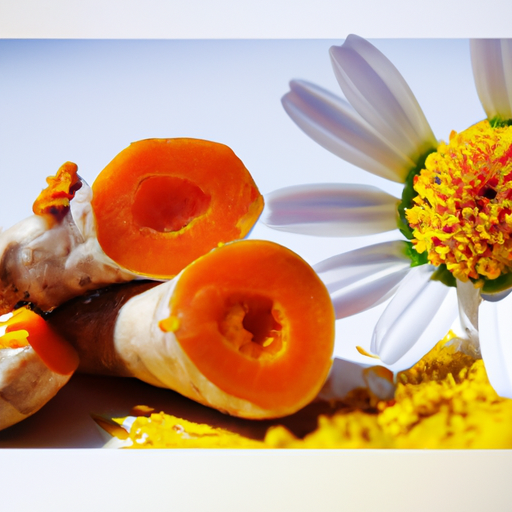What is turmeric and chamomile good for?
These two natural remedies have been used for centuries for their holistic healing properties. Turmeric, a vibrant golden spice, and chamomile, a delicate flower, offer a range of health benefits backed by scientific evidence.
Turmeric, known for its active compound curcumin, has potent anti-inflammatory and antioxidant effects. It can help reduce pain and inflammation, support brain health, improve digestion, and boost immune function.
Chamomile, on the other hand, is a calming herb that promotes relaxation, reduces anxiety and depression, aids in sleep, soothes skin irritations, and supports digestive health.
Incorporating turmeric into your diet is easy. You can add it to curries, soups, smoothies, or even sprinkle it on roasted vegetables. Chamomile can be enjoyed as a soothing tea or used topically as a skin treatment. However, it is important to consider any precautions or allergies before using these natural remedies.
Discover the power of turmeric and chamomile and unlock their incredible healing potential. Join me on this evidence-based journey to embrace the natural wonders of these ancient remedies.
Key Takeaways
- Turmeric is a natural remedy with holistic healing properties that has anti-inflammatory and antioxidant effects, reduces pain and inflammation, supports brain health, and improves digestion.
- Chamomile is a natural remedy with holistic healing properties that promotes relaxation, reduces anxiety and depression, aids in sleep, and soothes skin irritations.
- Turmeric is commonly used in curries, soups, smoothies, and on roasted vegetables, while chamomile is commonly used as a soothing tea or topically as a skin treatment.
- Both turmeric and chamomile have traditional uses in different medical practices and should be used with caution due to potential interactions with medications and possible side effects.
The Origins and History of Turmeric and Chamomile
Did you know that the origins and history of turmeric and chamomile are absolutely fascinating?
Turmeric, a bright yellow spice, has its roots in ancient India and has been used for thousands of years in traditional Ayurvedic medicine. It is derived from the rhizomes of the Curcuma longa plant and has been prized for its numerous health benefits.
Chamomile, on the other hand, has a long history of use in traditional European medicine. It is derived from the flowers of the Chamomilla recutita plant and is well-known for its calming and soothing properties.
While turmeric is commonly used for its anti-inflammatory and antioxidant effects, chamomile is often used to promote relaxation and relieve digestive issues.
Now, let’s delve into the health benefits of turmeric.
Health Benefits of Turmeric
Turmeric is a powerful herb that offers a wide range of health benefits. It has anti-inflammatory properties that can help reduce inflammation in the body. Turmeric is also known for its antioxidant effects, which can help protect the body against free radicals and oxidative stress. Additionally, it has been shown to support digestive health by promoting healthy digestion and reducing symptoms such as bloating and indigestion. Overall, incorporating turmeric into your daily routine can be a natural and effective way to support your overall health and well-being.
Anti-inflammatory Properties
By incorporating turmeric and chamomile into your daily routine, you’ll experience the soothing power of their anti-inflammatory properties. These natural remedies for inflammation have been used for centuries to alleviate discomfort and promote overall wellness.
The role of diet in reducing inflammation can’t be overstated, and these two ingredients are a delicious and easy way to incorporate anti-inflammatory foods into your meals. Here are four reasons why turmeric and chamomile are beneficial:
- Turmeric contains a compound called curcumin, which has been shown to reduce inflammation in the body.
- Chamomile has anti-inflammatory properties that can help soothe irritated skin and reduce redness.
- Both turmeric and chamomile have been used in traditional medicine to treat conditions such as arthritis and digestive disorders.
- Incorporating these ingredients into your diet can help support a healthy immune system and promote overall well-being.
With their anti-inflammatory properties, turmeric and chamomile are just the beginning of the natural remedies that can help you feel your best.
Antioxidant Effects
Indulging in the antioxidant effects of turmeric and chamomile will leave you feeling rejuvenated and invigorated. These powerful ingredients have been extensively studied for their antioxidant properties, which play a crucial role in protecting our bodies from harmful free radicals. Antioxidant research has shown that both turmeric and chamomile contain compounds that can help combat oxidative stress and reduce inflammation.
In fact, these herbs have been found to have even stronger antioxidant activity compared to many other commonly used herbs. Their natural composition makes them a safe and holistic choice for promoting overall well-being.
Moving forward, let’s explore how turmeric and chamomile can also provide support for digestive health without compromising on taste and enjoyment.
Digestive Health Support
Take a moment to discover how incorporating turmeric and chamomile into your routine can provide you with the digestive health support you need while still enjoying delicious flavors.
-
Turmeric, with its active compound curcumin, has been shown to have anti-inflammatory properties that can help soothe the digestive system and reduce symptoms of digestive issues. It also aids in the production of bile, which is essential for breaking down fats and supporting optimal digestion.
-
Chamomile, on the other hand, has been used for centuries as a natural remedy for digestive issues. It helps relax the muscles in the gastrointestinal tract, reducing spasms and relieving symptoms such as bloating and gas. Chamomile also has anti-inflammatory properties that can help reduce inflammation in the gut.
By incorporating turmeric and chamomile into your routine, you can support your digestive health naturally.
Now, let’s explore the health benefits of chamomile in the next section.
Health Benefits of Chamomile
Discover the incredible health benefits of chamomile, a natural remedy that can help you relax, reduce anxiety, and promote better sleep.
Chamomile is widely known for its soothing properties, making it a popular choice for those seeking natural ways to improve their overall well-being.
This herb contains compounds like apigenin, which have been shown to have anti-anxiety effects, helping to calm the mind and reduce stress levels.
Additionally, chamomile has been found to promote better sleep quality, making it a great option for those struggling with insomnia or restless nights.
To reap the benefits of chamomile, you can enjoy it as a tea, incorporate it into your bath routine, or even apply it topically for skin conditions.
Now, let’s explore how to incorporate turmeric into your diet for even more health benefits.
How to Incorporate Turmeric into Your Diet
When it comes to enhancing our health and well-being, incorporating natural remedies into our daily routine can have a profound impact. In the previous section, we explored the numerous health benefits of chamomile, a gentle herb known for its calming properties. Now, let’s delve into the world of turmeric, a vibrant yellow spice that has been used for centuries in traditional medicine. Turmeric contains a compound called curcumin, which has been shown to have powerful anti-inflammatory and antioxidant effects. Adding turmeric powder to your meals or taking turmeric supplements can be an excellent way to harness its potential benefits. To help you incorporate turmeric into your diet, I have created a handy table that showcases four simple and delicious ways to enjoy this golden spice. So, let’s explore the wonders of turmeric and discover how it can enhance our health. And now, let’s move on to the next section on how to incorporate chamomile into your routine.
How to Incorporate Chamomile into Your Routine
If you’re looking to add a touch of tranquility to your daily routine, incorporating chamomile into your regimen might just be the ironic twist you need.
Chamomile has been used for centuries as a natural remedy for its calming and soothing properties. One way to incorporate chamomile into your routine is by enjoying a cup of chamomile tea. There are plenty of chamomile tea recipes available online that can help you find the perfect blend for your taste buds.
Additionally, chamomile can also be beneficial for your skincare routine. It has anti-inflammatory properties that can help soothe and calm irritated skin. You can make a chamomile-infused toner or add chamomile essential oil to your moisturizer for added benefits.
When it comes to incorporating chamomile into your routine, the possibilities are endless. Just remember to do your research and consult with a healthcare professional if needed.
Now, let’s move on to the precautions and considerations when using chamomile.
Precautions and Considerations
To ensure the safe and effective use of chamomile, it’s important for you to take note of the precautions and considerations. Here are some key points to keep in mind:
-
Precautions: Chamomile may cause allergic reactions in individuals who are sensitive to plants in the daisy family. It’s advisable to avoid chamomile if you’re pregnant or breastfeeding, as there’s insufficient evidence regarding its safety in these situations. Chamomile can interact with certain medications, so consult with your healthcare provider before incorporating it into your routine.
-
Dosage Recommendations: There’s no standard dosage for chamomile, but it’s generally recommended to start with a low dose and gradually increase if needed. It’s advisable to follow the instructions on the product packaging or consult with a healthcare professional for specific dosage guidance.
Considering these precautions and dosage recommendations will help you make informed decisions about incorporating chamomile into your routine. Moving forward, let’s delve into the conclusion and final thoughts on the topic.
Conclusion and Final Thoughts
In summary, considering the precautions and dosage recommendations discussed, it is clear that incorporating chamomile into your routine can be a safe and beneficial choice for promoting overall well-being. Chamomile has been used for centuries as a natural remedy for various health conditions, including anxiety, insomnia, and digestive issues. It is known for its calming properties and can help reduce inflammation in the body. However, it is important to note that chamomile may cause allergic reactions in some individuals, especially those who are allergic to ragweed. It is also recommended to consult with a healthcare professional before using chamomile, especially if you are pregnant or breastfeeding.
When it comes to turmeric, it is also a natural remedy with potential health benefits. Turmeric contains a compound called curcumin, which has anti-inflammatory and antioxidant properties. It has been used traditionally to treat conditions such as arthritis, digestive disorders, and skin problems. However, it is important to be cautious with turmeric, as it may cause gastrointestinal issues and interact with certain medications. It is recommended to use turmeric in moderation and consult with a healthcare professional before starting any new supplement or treatment.
To summarize, both turmeric and chamomile have natural healing properties and can be beneficial for overall well-being. However, it is important to be aware of potential side effects and consult with a healthcare professional before incorporating them into your routine.
| Turmeric | Chamomile |
|---|---|
| Anti-inflammatory properties | Calming and soothing effects |
| Antioxidant properties | Reduces inflammation in the body |
| Used for arthritis and digestive disorders | Helps with anxiety and insomnia |
| Potential gastrointestinal issues | May cause allergic reactions in some individuals |
| Interacts with certain medications | Consult with a healthcare professional before use |
Frequently Asked Questions
Can turmeric and chamomile be used together for better health benefits?
Turmeric and chamomile can indeed be used together for better health benefits. They are known for their anxiety-relieving properties and can also promote healthy skin. It’s a natural and evidence-based approach to holistic well-being.
Are there any known side effects or interactions with medications when using turmeric and chamomile?
When using turmeric and chamomile, it’s important to be aware of potential side effects and interactions with medications. It’s always best to consult with a healthcare professional to ensure their safe and effective use.
How long does it take to see the health benefits of turmeric and chamomile?
It usually takes a few weeks to see the health benefits of turmeric and chamomile. The dosage can vary, but for skin benefits, applying a turmeric and chamomile paste can be effective.
Can turmeric and chamomile help with weight loss?
Yes, turmeric and chamomile can help with weight loss. They act as sleep aids, reducing inflammation and promoting a healthy metabolism. Studies suggest their natural properties support weight management when incorporated into a balanced lifestyle.
Are there any specific dosages or recommended amounts of turmeric and chamomile for optimal health benefits?
For optimal health benefits, it is important to follow recommended dosages of turmeric and chamomile. However, it is crucial to be aware of potential risks and consult with a healthcare professional before starting any new regimen.
Conclusion
In conclusion, both turmeric and chamomile have a long history of use for their health benefits. Turmeric is known for its powerful anti-inflammatory properties, while chamomile is valued for its calming effects on the body and mind.
Incorporating these natural remedies into your daily routine can have a positive impact on your overall well-being. Interestingly, studies have shown that turmeric can help reduce symptoms of depression and anxiety, making it a valuable addition to a holistic approach to mental health.
So why not give these natural wonders a try and experience the benefits for yourself?










